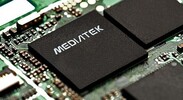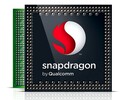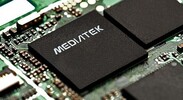Mediatek Helio P10 MT6755 vs Qualcomm Snapdragon 801 MSM8974AB vs Mediatek MT6750S
Mediatek Helio P10 MT6755
► remove from comparison
The Mediatek Helio P10 MT6755 is a mid-range ARM SoC for smartphones and tablets that was available starting in Q3 2015. The octa-core processor includes eight 64 Bit Cortex-A53 cores clocked with up to 2 GHz. Furthermore a ARM Mali-T860 MP2 graphics card with up to 700 MHz and a LTE Cat. 6 modem is integrated.
The performance of the CPU cores si similar to the Kirin 930 and therefore in the mid-range of smartphone SoCs in 2015 and 2016.
The SoC is manufactured at TSMC in 28nm (HPC+) and also suited for smartphones (e.g. the Elephone P9000).
Qualcomm Snapdragon 801 MSM8974AB
► remove from comparison
The Qualcomm Snapdragon 801 MSM8974AB is an ARM-based SoC for tablets and smartphones. It is built at TSMC in a 28nm HPM (High Performance Mobile) HKMG process, whereas the Snapdragon 600 was manufactured in 28nm LP. In addition to 4 CPU cores with a clock speed of up to 2.36 GHz, the chip also integrates an Adreno 330 GPU up to 578 MHz, an LPDDR3-1866 memory controller and various radio modules (UMTS/LTE, WiFi, Bluetooth, GPS). The slightly higher CPU/GPU clocks and faster memory support are the key differences to the Snapdragon 800 MSM8974.
Processor
The CPU portion is based on Qualcomm's Krait architecture, which is compatible with the ARMv7 ISA. Compared to the Snapdragon 600 (Krait 300), the new Krait 400 cores of the Snapdragon 800/801 have been tweaked just slightly with faster L2 cache. Thanks to a clock rate of up to 2.36 GHz and a high performance per MHz somewhere between an ARM Cortex-A9 and a Cortex-A15, the Snapdragon 801 offers very strong CPU performance. The S801 competes with the Nvidia Tegra 4, Samsung Exynos 5420 and Apple A7 and is therefore one of the fastest ARM SoCs on the market as of 2013.
Graphics
Another difference between the Snapdragon 600 and 800/801 is the graphics unit. While the S600 implements an Adreno 320 (400 to 450 MHz), the S800 /S801 feature the faster Adreno 330 (MSM8974AB: 578 MHz). Both GPUs offer the same amount of texture units (8 TMUs), but the Adreno 330 has 50 percent more shaders (probably 6x SIMD16 vs. 4x SIMD16 of the previous generation). In conjunction with the higher memory bandwidth, the performance is significantly better. As a result, the Adreno 330 is slightly faster than the Mali-T628 (Exynos 5420) and the PowerVR G6430 (Apple A7). Depending on the device and cooling, however, the performance may vary. The GPU supports OpenGL ES 3.0 as well as OpenCL 1.2.
Features
Furthermore, the MSM8974AB supports many wireless technologies: Bluetooth 4.0, WLAN, IEEE 802.11a/b/g/n/ac (2.4/5 GHz), GSM (GPRS, EDGE), W-CDMA/UMTS (HSDPA, HSUPA, HSPA+, cat.29 DC-HSPA+), MBMS, cat.4 LTE, CDMA2000 (1X RTT, 1 × EV-DO Rel.0/Rev.A/Rev.B, 1× EV-DO Rev.A MC, 1× Adv Rev.A/Rev.B) and TD-SCDMA.
The MSM8974AB can encode and play UHD 4K videos in 3840x2160 at 30 FPS (120 Mbps H.264 High Profile) simultaneously via dedicated hardware. Moreover, it supports both USB 2.0 and 3.0 and cameras up to 55 megapixels and stereoscopic 3D.
Power Consumption
Thanks to the new 28nm HPM HKMG process, the energy efficiency has been improved significantly compared to its LP 28nm S600 predecessor. Depending on the field of application, the maximum power consumption should be about 3 W for smartphones or 4 W or greater for tablets. This should be similar to comparable ARM SoCs currently in the market. However, the MSM8974AB will likely to need a little more power than the slightly lower clocked MSM8974.
Mediatek MT6750S
► remove from comparison
The ARM-based Mediatek MT6750N SoC (System on a Chip) is a mid-range mobile processor for smartphones and tablets (mostly Android based). It integrates 8 ARM Cortex-A53 cores consisting of 4 high-performance cores clocked at up to 1.5 GHz plus 4 low-power cores clocked at up to 1 GHz each. Furthermore, the SoC integrates a Cat. 6 LTE radio and an ARM Mali-T860 MP2 GPU with 802.11n WiFi and Bluetooth connectivity. Compared to the older MT6750, the graphics card seems to be clocked higher.
The Cortex-A53 is the successor to the Cortex-A7 and introduces 64-Bit support (ARMv8-ISA). Its performance-per-Watt is significantly higher and is even slightly ahead of the old Cortex-A9. If utilizing all 8 of its cores, the Cortex-A53 can rival competing mobile processes in the high-end class range. However, no practical software has been specifically coded to use all 8 cores at such high performance levels.
In addition to the CPU and GPU cores, the SoC also contains a memory controller and the aforementioned Cat.6 LTE modem (FDD/TDD, DC-HSPA+, TD-SCDMA, CDMA2000, EDGE) with both 802.11n WiFi and Bluetooth. The integrated video engine is able to record and playback 1080p videos at up to 30 FPS in hardware. Cameras are supported at up to 16 MP.
The MT6750 is still manufactured in 28nm and so power efficiency is not on par with modern 14/16nm chips.
| Model | Mediatek Helio P10 MT6755 | Qualcomm Snapdragon 801 MSM8974AB | Mediatek MT6750S | ||||||||||||||||||||||||||||||||||||||||||||||||||||||||||||||||||||||||||||||||||||||||||||||||||||||||||||||||||||||||||||||||||||||||||||||||||||||||||||||||||||||||||||||||||||||||||||||||||||
| Codename | Cortex-A53 | Krait 400 | Cortex-A53 | ||||||||||||||||||||||||||||||||||||||||||||||||||||||||||||||||||||||||||||||||||||||||||||||||||||||||||||||||||||||||||||||||||||||||||||||||||||||||||||||||||||||||||||||||||||||||||||||||||||
| Series | Mediatek Mediatek | Qualcomm Snapdragon | Mediatek | ||||||||||||||||||||||||||||||||||||||||||||||||||||||||||||||||||||||||||||||||||||||||||||||||||||||||||||||||||||||||||||||||||||||||||||||||||||||||||||||||||||||||||||||||||||||||||||||||||||
| Series: Mediatek Cortex-A53 |
|
|
| ||||||||||||||||||||||||||||||||||||||||||||||||||||||||||||||||||||||||||||||||||||||||||||||||||||||||||||||||||||||||||||||||||||||||||||||||||||||||||||||||||||||||||||||||||||||||||||||||||||
| Clock | 2000 MHz | 2360 MHz | 1500 MHz | ||||||||||||||||||||||||||||||||||||||||||||||||||||||||||||||||||||||||||||||||||||||||||||||||||||||||||||||||||||||||||||||||||||||||||||||||||||||||||||||||||||||||||||||||||||||||||||||||||||
| Cores / Threads | 8 / 8 | 4 / 4 | 8 / 8 | ||||||||||||||||||||||||||||||||||||||||||||||||||||||||||||||||||||||||||||||||||||||||||||||||||||||||||||||||||||||||||||||||||||||||||||||||||||||||||||||||||||||||||||||||||||||||||||||||||||
| Technology | 28 nm | 28 nm | 28 nm | ||||||||||||||||||||||||||||||||||||||||||||||||||||||||||||||||||||||||||||||||||||||||||||||||||||||||||||||||||||||||||||||||||||||||||||||||||||||||||||||||||||||||||||||||||||||||||||||||||||
| Features | UMTS/HSPA+, LTE Cat. 4, TD-SCDMA, Dual-Channel LPDDR3-1866 Memory Controller, 4K Video Encoder, H.265, PowerVR Series 6 GPU | Adreno 330 (578 MHz), LTE cat.4, UMTS, MBMS, GSM, CDMA2000, tD-SCDMA, 802.11a/b/g/n/ac (2.4/5 GHz), Bluetooth 4.0, 2x 32 Bit LPDDR3-1866 Memory Controller (14.9 GB/s) | Cat. 6 LTE (FDD & TDD), DC-HSPA+, TD-SCDMA, CDMA2000, EDGE, 802.11a/b/g/n WiFi, Bluetooth, 16 MP ISP, 1080p recording/playback, ARM Mali-T860 MP2 GPU | ||||||||||||||||||||||||||||||||||||||||||||||||||||||||||||||||||||||||||||||||||||||||||||||||||||||||||||||||||||||||||||||||||||||||||||||||||||||||||||||||||||||||||||||||||||||||||||||||||||
| iGPU | ARM Mali-T860 MP2 (700 MHz) | Qualcomm Adreno 330 (578 MHz) | ARM Mali-T860 MP2 ( - 530 MHz) | ||||||||||||||||||||||||||||||||||||||||||||||||||||||||||||||||||||||||||||||||||||||||||||||||||||||||||||||||||||||||||||||||||||||||||||||||||||||||||||||||||||||||||||||||||||||||||||||||||||
| Architecture | ARM | ARM | ARM | ||||||||||||||||||||||||||||||||||||||||||||||||||||||||||||||||||||||||||||||||||||||||||||||||||||||||||||||||||||||||||||||||||||||||||||||||||||||||||||||||||||||||||||||||||||||||||||||||||||
| Announced | |||||||||||||||||||||||||||||||||||||||||||||||||||||||||||||||||||||||||||||||||||||||||||||||||||||||||||||||||||||||||||||||||||||||||||||||||||||||||||||||||||||||||||||||||||||||||||||||||||||||
| Manufacturer | www.mediatek.com | www.mediatek.com | |||||||||||||||||||||||||||||||||||||||||||||||||||||||||||||||||||||||||||||||||||||||||||||||||||||||||||||||||||||||||||||||||||||||||||||||||||||||||||||||||||||||||||||||||||||||||||||||||||||
| L1 Cache | 0 MB | ||||||||||||||||||||||||||||||||||||||||||||||||||||||||||||||||||||||||||||||||||||||||||||||||||||||||||||||||||||||||||||||||||||||||||||||||||||||||||||||||||||||||||||||||||||||||||||||||||||||
| L2 Cache | 2 MB |
Benchmarks
Average Benchmarks Mediatek Helio P10 MT6755 → 100% n=5
Average Benchmarks Qualcomm Snapdragon 801 MSM8974AB → 96% n=5
Average Benchmarks Mediatek MT6750S → 85% n=5
* Smaller numbers mean a higher performance
1 This benchmark is not used for the average calculation













